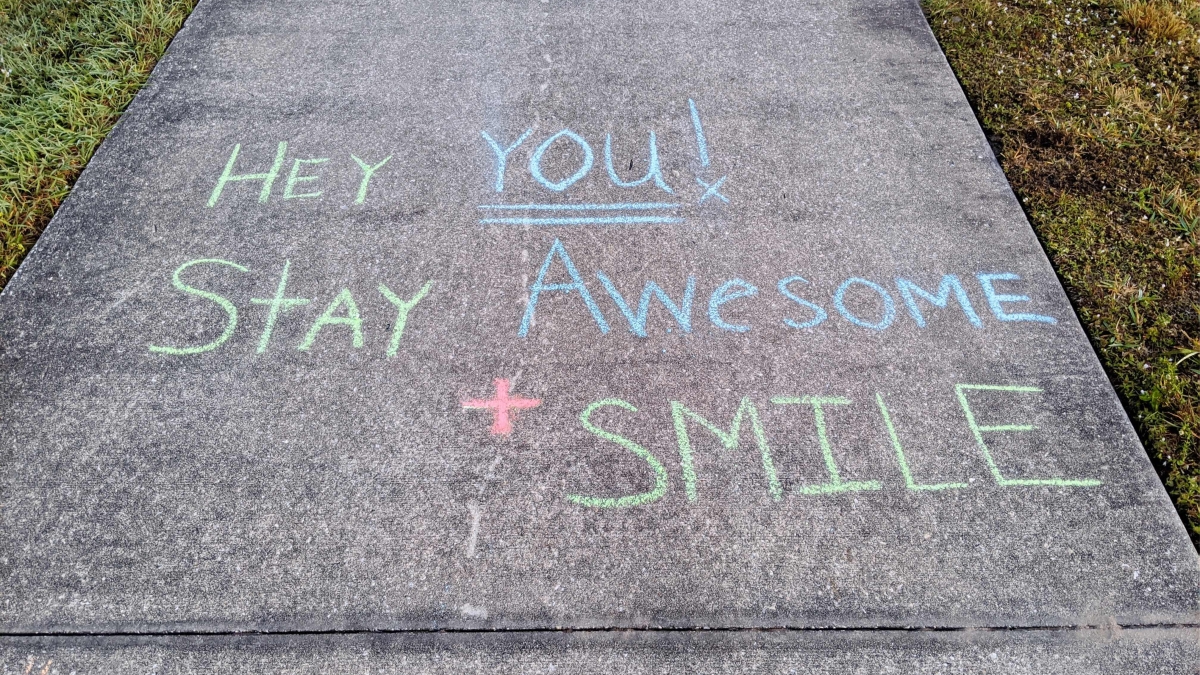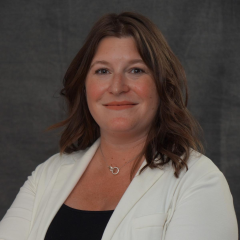In spring 2020, as the pandemic and resulting stay-at-home orders shuttered schools and indoor public spaces, many people found themselves holed up in their homes while still yearning to remain social creatures.
From that desire for human connection, an unlikely communication outlet and form of creative expression emerged: chalk messages on neighborhood streets, sidewalks and driveways. Across the Valley, residents took to their asphalts and pavements to etch colorful words sharing messages of support, anguish, loss and triumph.
Deirdre Pfeiffer and her 4-year-old daughter spent many days walking hand-in-hand along the streets of Phoenix on the hunt for just such chalk messages. And they found several.
Deirdre Pfeiffer
“We will be okay.”
“Happy B-Day Audrey.”
“Have a good rest of your day — the Austin’s.”
Pfeiffer, an associate professor of planning in Arizona State University's School of Geographical Sciences and Urban Planning, wanted to better understand this social phenomenon – where it was happening, how neighbors were engaging with one another and how the pandemic brought residents to use their neighborhoods in novel ways.
“Driveways, sidewalks and streets became canvasses for people, even a diary at times,” said Pfeiffer, whose research examines housing and health. “The way that this infrastructure helped people to communicate was really surprising, and they communicated in different ways.”
The results of her study, done in collaboration with Meagan Ehlenz, a fellow School of Geographical Sciences and Urban Planning associate professor, and Rababe Saadaoui, an ASU urban planning PhD student, were recently published in the Journal of Planning Education and Research.
Messages of coping and connection
Over the course of the first 14 months of the pandemic, from March 2020 to May 2021, the team of ASU student and faculty researchers documented the different ways people used neighborhood infrastructure to connect with one another.
At determined intervals, the research team surveyed three chosen Phoenix neighborhoods, taking photos of chalk and street art that appeared and analyzing the messages, grouping them into a variety of coping and connective functions. The team then compared their findings to pre-pandemic uses of the same spaces by reviewing Google Street View images.
Meagan Ehlenz
They found that people used neighborhood space to communicate a variety of coping sentiments and feelings — not only positivity, excitement and solidarity, but also anxiety and sadness.
Driveways and sidewalks became mediums for expressions of intimate emotions and support, or signs of care. Drawings of smiley faces, rainbows and hearts were often combined with advice or affirmation, while song lyrics written on a sidewalk conveyed emotional tones of what people were going through.
“Every journey starts with one step,” one message said.
“Con amor todo es posbile/with love anything is possible,” another said
“Be Strong Lynda,” yet another said.
Additionally, the research found that residents used their streets as a form of connective practice, taking events that, pre-pandemic, typically would only happen between family and friends, and making them neighborhood events. For example, since large gatherings were unsafe, people began to use driveways as birthday cards or congratulatory message boards for newly expecting parents, soliciting participation from neighbors.
“Eric is 50 today! Leave a message!” one message said.
“Welcome Baby Elsie,” another said.
“Not only were people using these spaces that you would ordinarily use to just walk on or park cars in a different way, but they were also bringing neighbors into these very personal events,” Pfeiffer said. “It really shows the potential for this transportation infrastructure to do other things than to park cars.”
Untapped potential
A better understanding of the alternative roles that can be played by streets, sidewalks and driveways provides insight into how these spaces could be used differently in the future and the value they provide beyond transportation use, Pfeiffer says.
With the rise of self-driving car companies like Waymo and Cruise on the horizon, researchers say the demands to own cars may change, and so will the spaces designed to hold them.
"You could sign up for a membership through one of these self-driving car companies,” Pfeiffer said. “So, what does that mean for all these garages and driveways that we all have that may become potentially useless in the future?
“I think the project shows the potential for these spaces to do these other things.”
Researchers also analyzed the extent to which this change was fleeting. The study found that messages proliferated over about a year from the beginning of the pandemic, then began to dissipate as stay-at-home orders and other markers of the end of a period of isolation began to lift, concluding that there was a very acute period of using streets and sidewalks for creativity and connection.
“What I appreciate most about this research is how it shows the organic nature of community and socialization, even during a period where the ‘typical’ ways of socialization weren’t readily available,” said Ehlenz, a co-author of the study. “Rather than going to community events or greeting each other over coffee, this research embodies the ways creativity can memorialize a moment — even if for a short time — and allow neighborhoods to connect, reflect and process.”
Research that brings people together
For Pfeiffer and her daughter, finding and taking photos of street messages and art was in itself a form of connection and play.
The field research from this study was a result of the creative work of ASU students, faculty and their families. The ASU School of Geographical Sciences and Urban Planning employed students who lost jobs because of the pandemic to help collect the data through a school-run internship program.
“We were able to collaborate with the student interns fully remotely, and two of us (Pfeiffer and Ehlenz) involved our kids, who were at home because of day care and school closures, in the data collection,” Pfeiffer said. “We were all participants to some extent in this research in our own communities.”
Top photo by Philip Arambula/Unsplash
More Health and medicine

Dynamic data duo advances health research
The latest health research promises futuristic treatments, from cancer vaccines to bioengineered organs for transplants to medical nanobots. While these technologies may one day be…

New study reveals high levels of toxins in seized cannabis from Arizona and California
A recent study conducted by researchers from Arizona State University has uncovered alarming levels of Fusarium mycotoxins in illicit cannabis samples seized in Arizona and California.The study found…

PhD student builds bridges with construction industry to prevent heat-related illnesses
It is no secret that Arizona State University has innovative researchers working to help solve everyday problems.According to a new preliminary report issued by Maricopa County, there were more…




